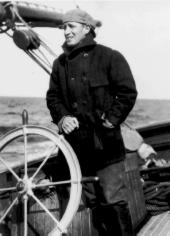1911
On July 7th the United States~ Great Britain (for Canada)~ Japan, and
Russia conclude a convention for the protection of the North Pacific
fur seals that had been virtually decimated by overhunting on the high
seas. This provides a sound basis for managing the species.
The Albatross returns to San Francisco after a trip along the
California coast in which six yearling elephant seals, thought to be
extinct, are captured and sent to the New York Aquarium.
The Alaska Fishery and Fur Seal Service is separated from the
Division of Scientific Inquiry and made an operating Division of the
Bureau of Fisheries.
 H.B. Bigelow
H.B. Bigelow
1912
H.B. Bigelow begins sixteen years of research on the oceanic fisheries
in the Gulf of Maine. This fundamental work, along with extensive
investigations with W.B. Schroeder results in the 1953 treatise "Fishes
of the Gulf of Maine," a standard reference in the field.
The eruption of Alaska's Mount
Katmai covers a Bureau salmon hatchery
with nearly a foot of volcanic ash.
1913
The Bureau of Fisheries publishes results of a massive bottom sampling
program operated out of Woods Hole, describing the distribution of
about 250 animal and plant species at several hundred sampling
stations.
The Department of Labor is separated from the Department of Commerce,
which retains the Bureau of Fisheries.
A study on age determination of Pacific salmon is begun by Charles
Gilbert, initially using the scales of fish collected from the Columbia
and Fraser Rivers.
1914
A small office opens in Seattle's historic Smith Tower Building as an
administrative center for the Bureau's Pacific coast operations.
1915
The Department of Commerce and Labor becomes the Department of
Commerce.
William F. Thompson, an early student of David Starr Jordan's, begins
his study of the halibut fisheries of the North Pacific; later he will
become the director of investigations for the International (Halibut)
Fisheries Commission, the International Pacific Salmon Fisheries
Commission, and the Fisheries Research Institute of the University of
Washington. This halibut research is the first scientific study made on
the Pacific coast fishery that is aimed at fishery management.
Congress approves the appointment of a full-time fish pathologist to
the Bureau staff.
1915-21 The Albatross conducts research off Oregon, Washington, and
California, including tuna studies of southern California and Baja
California. However, during World War I, the Albatross is placed under
U.S. Navy direction and patrols the Gulf of Mexico and Caribbean Sea
region.
1917
The Albatross undergoes repairs for a November transfer to the U.S.
Navy for the duration of WWI. It is returned to the Bureau in 1919
Research emphasis at the lab is changed from general interest to work
concentrating on the immediate increase of aquatic food supplies--a
change precipitated by the onset of World War I. During this time, the
Navy occupies the lab.
Fire destroys the fisheries laboratory building at Fairport, lowa, with
total loss of a collection of rare scientific papers related to
freshwater mussels.
1918
The U.S. Navy takes over the Bureau's Beaufort, N.C., fisheries
laboratory in World War I to study the fouling of ship bottoms, and
returns it to the Bureau in 1920.
Funding is approved for the first fishery products laboratory, in
Washington, D.C. to house rooms for drying, smoking, canning and
refrigerating of fish. An experimental kitchen is also built.
The first of 125 nationwide cooking demonstrations begins in Seattle to
show consumers the best and most economic ways of preparing and cooking
fish.
The Supreme Count confirms its prior opinion enjoining Alaska Pacific
Fisheries "from maintaining" and compelling it to remove, a fish trap
erected by it in Annette island Waters. Alaska.
1919
The Bureau reports that, "In no branch of the fisheries is there greater
need for exhaustive study than in the methods or preservation of
fishery products"
Vinal Edwards dies on April 5. Vinal was the first permanent employee
of the Bureau of Fisheries.

Home